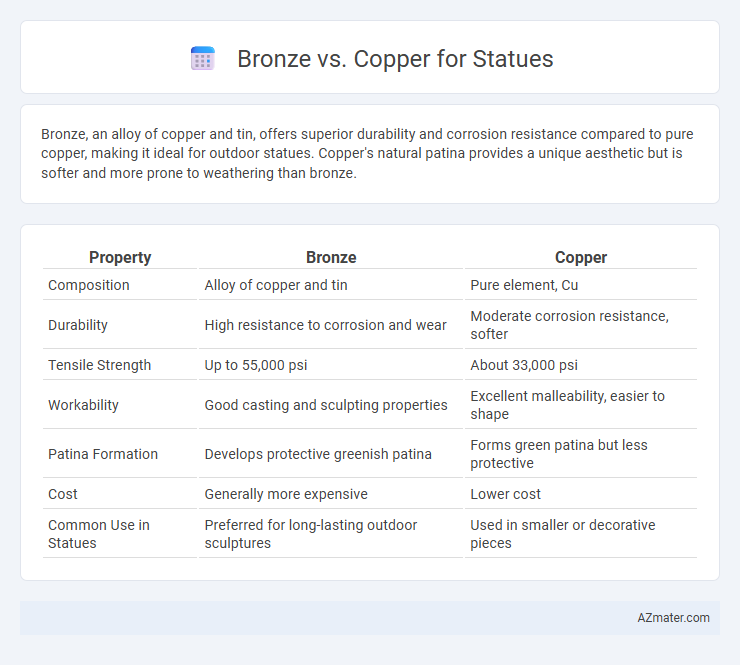Bronze, an alloy of copper and tin, offers superior durability and corrosion resistance compared to pure copper, making it ideal for outdoor statues. Copper's natural patina provides a unique aesthetic but is softer and more prone to weathering than bronze.
Table of Comparison
| Property | Bronze | Copper |
|---|---|---|
| Composition | Alloy of copper and tin | Pure element, Cu |
| Durability | High resistance to corrosion and wear | Moderate corrosion resistance, softer |
| Tensile Strength | Up to 55,000 psi | About 33,000 psi |
| Workability | Good casting and sculpting properties | Excellent malleability, easier to shape |
| Patina Formation | Develops protective greenish patina | Forms green patina but less protective |
| Cost | Generally more expensive | Lower cost |
| Common Use in Statues | Preferred for long-lasting outdoor sculptures | Used in smaller or decorative pieces |
Introduction: Why Choose Bronze or Copper for Statues?
Bronze, an alloy of copper and tin, offers superior durability and resistance to corrosion compared to pure copper, making it ideal for outdoor statues exposed to weather elements. Copper's natural patina provides an attractive, ever-changing surface that enhances aesthetic appeal, especially in indoor or protected settings. Choosing between bronze and copper depends on the desired longevity, environmental exposure, and artistic finish of the statue.
Historical Use of Bronze and Copper in Sculpture
Bronze, an alloy of copper and tin, has predominated in sculpture since ancient times due to its durability and ability to capture fine details, as seen in iconic works like the Greek Riace Warriors and Renaissance masterpieces by Donatello. Copper, used in earlier and simpler sculptures, offers a reddish hue but lacks the strength and corrosion resistance of bronze, which leads to its limited use in large-scale statues. The historical preference for bronze in statuary reflects advancements in metal alloying that enabled artists to achieve greater artistic expression and longevity.
Composition and Material Differences
Bronze, an alloy primarily composed of copper and tin, offers greater strength and durability compared to pure copper, making it ideal for statues requiring intricate detail and long-lasting structural integrity. Copper, a soft and malleable metal with a reddish hue, is less resistant to corrosion and wear, resulting in statues that may develop patina or degrade more quickly in outdoor environments. The inclusion of tin in bronze enhances hardness and casting ability, whereas copper's higher thermal and electrical conductivity suits different artistic and functional applications.
Durability and Longevity: Bronze vs Copper Statues
Bronze statues exhibit superior durability and longevity compared to copper ones due to their alloy composition, which enhances resistance to corrosion and weathering. Copper statues tend to develop a green patina over time, which can lead to surface degradation if not properly maintained, whereas bronze maintains structural integrity longer in outdoor environments. The copper-tin alloy in bronze forms a harder, more stable material, making bronze the preferred choice for enduring public monuments and sculptures.
Workability and Sculpting Processes
Bronze offers superior workability in statue creation due to its excellent fluidity when melted, allowing for detailed casting and intricate sculpting with fine textures. Copper, while softer and easier to shape in its pure form, lacks the strength and durability of bronze, leading to less precise detailing and greater susceptibility to deformation during the sculpting process. The alloy composition of bronze enhances its hardness and corrosion resistance, making it the preferred material for sculptors aiming for longevity and intricate craftsmanship.
Aesthetic Appeal: Color, Finish, and Patina
Bronze statues exhibit a rich, warm color palette that ranges from deep brown to golden hues, developing a desirable green or blue-green patina over time which enhances their aesthetic appeal. Copper statues initially showcase a reddish-orange tone that gradually transforms into a vibrant emerald patina, providing a unique and eye-catching finish. The durable finish of bronze resists corrosion better, maintaining its polished look longer than copper, which develops a more rustic and organic charm through natural weathering.
Resistance to Weather and Corrosion
Bronze, an alloy primarily composed of copper and tin, offers superior resistance to weather and corrosion compared to pure copper, making it a preferred material for outdoor statues. It develops a stable patina that protects the underlying metal from oxidation, enhancing durability against rain, wind, and pollutants. Copper statues, while initially more prone to surface corrosion and green patina formation, generally require more maintenance to preserve their structural integrity over time.
Cost Comparison: Bronze vs Copper for Statues
Bronze statues typically cost more than copper ones due to the alloy composition, which includes tin along with copper, increasing material and production expenses. The casting process for bronze requires higher temperatures and more precise techniques, further elevating costs compared to pure copper statues. Maintenance costs differ as well; bronze develops a patina that protects it, potentially reducing long-term preservation expenses, whereas copper may require more frequent upkeep to prevent corrosion.
Notable Examples of Bronze and Copper Statues Worldwide
Notable bronze statues worldwide include the iconic Christ the Redeemer in Brazil, celebrated for its durability and intricate detail, and the Statue of Liberty in the USA, where bronze's strength preserves the monument's structure. Copper statues, such as the outfacing heads of Mount Rushmore and various Eastern Hindu deities, showcase the metal's distinctive green patina and cultural significance despite copper being softer and less weather-resistant than bronze. Both metals have been historically chosen for statuary due to their unique aesthetic qualities and longevity in diverse climates.
Choosing the Right Metal: Factors to Consider for Statue Projects
Bronze offers superior durability and weather resistance compared to copper, making it ideal for outdoor statues exposed to harsh environmental conditions. Copper provides a distinct reddish tone and develops a natural patina over time, enhancing aesthetic appeal but requiring more maintenance in humid or acidic environments. Consider factors such as structural strength, longevity, corrosion resistance, and desired visual effects when selecting between bronze and copper for statue projects.

Infographic: Bronze vs Copper for Statue
 azmater.com
azmater.com